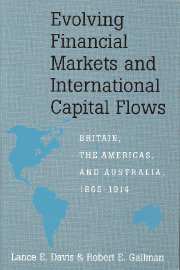 Evolving Financial Markets and International Capital Flows
Evolving Financial Markets and International Capital Flows Book contents
- Frontmatter
- Contents
- 1 Institutional invention and innovation: Foreign capital transfers and the evolution of the domestic capital markets in four frontier countries: Argentina, Australia, Canada, and the United States, 1865–1914
- 2 The United Kingdom
- 3 International capital movements, domestic capital markets, and American economic growth, 1865–1914
- 4 Domestic savings, international capital flows, and the evolution of domestic capital markets: The Canadian experience
- 5 Domestic saving, international capital flows, and the evolution of domestic capital markets: The Australian experience
- 6 Argentine savings, investment, and economic growth before World War I
- 7 Lessons from the past: International financial flows and the evolution of capital markets, Britain and Argentina, Australia, Canada, and the United States before World War I
- 8 Skipping ahead: The evolution of the world's finance markets 1914–1990 – A brief sketch
- 9 Lessons from the past
- Bibliography
- Index
6 - Argentine savings, investment, and economic growth before World War I
Published online by Cambridge University Press: 18 August 2009
- Frontmatter
- Contents
- 1 Institutional invention and innovation: Foreign capital transfers and the evolution of the domestic capital markets in four frontier countries: Argentina, Australia, Canada, and the United States, 1865–1914
- 2 The United Kingdom
- 3 International capital movements, domestic capital markets, and American economic growth, 1865–1914
- 4 Domestic savings, international capital flows, and the evolution of domestic capital markets: The Canadian experience
- 5 Domestic saving, international capital flows, and the evolution of domestic capital markets: The Australian experience
- 6 Argentine savings, investment, and economic growth before World War I
- 7 Lessons from the past: International financial flows and the evolution of capital markets, Britain and Argentina, Australia, Canada, and the United States before World War I
- 8 Skipping ahead: The evolution of the world's finance markets 1914–1990 – A brief sketch
- 9 Lessons from the past
- Bibliography
- Index
Summary
Introduction
As a result of the revolutionary movement in Spain's American empire, Argentina achieved independence early in the nineteenth century. By 1810 Buenos Aires was free, de facto, and by 1816, de jure; but the wars continued (with Argentine participation) until 1824, when the Spanish empire in America was largely liquidated. Conditions in Argentina continued unsettled until 1829, when the dictator Juan Manuel Rosas came to power. Traditional historiography treats the period of the Rosas regime as a time of political and social retrogression and economic stagnation:
The History of Argentina to 1860 is still commonly framed in the mythic terms imposed by Domingo Sarmiento in his novel Facundo. According to Sarmiento's enduring trope, the failure by 1820 of the first Republican experiments led inexorably to a bloody conflict between “civilization and barbarism.” Central to this dramatic representation of the region's history is the assertion of a fundamental rivalry between rural and urban cultures. Federalism and Unitarism were, therefore, ideological expressions of antithetical cultural traditions. The brutality, cruelty, and personalism of Juan Manuel de Rosas were natural and predictable given the brutishness, isolation, and pure physicality of life on the livestock frontier that spawned him.
No one denies the cruelty or political repression of the Rosas regime, nor even its opposition to the expansion of economic ties with Europe and North America; but modern interpreters do not find evidence of economic failure and stagnation during this period.
- Type
- Chapter
- Information
- Evolving Financial Markets and International Capital FlowsBritain, the Americas, and Australia, 1865–1914, pp. 644 - 752Publisher: Cambridge University PressPrint publication year: 2001
